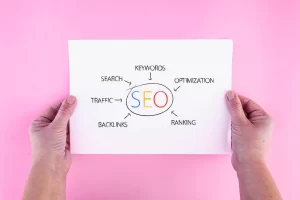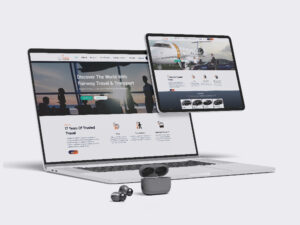You’ve got a great website. Your content is strong, your design looks sharp—but for some reason, your site just isn’t showing up where it should on Google. Frustrating, right?
Well, here’s the truth: even small technical SEO issues can quietly hurt your rankings. It’s like having a fast car with a flat tire—you’ve got the power, but something under the hood is holding you back.
From slow loading speeds to broken links and messy site structures, these hidden technical seo issues can make search engines—and visitors—turn away. And the worst part is that you might not even know they’re there.
In this blog, we’re breaking down the top 10 technical SEO issues that could be hurting your rankings and showing you how to fix them before they do more damage.
Let’s look into it and get your site back on track!

-
Website Speed
Imagine you want to search for something online — maybe shopping, information, or anything else. But when you click on a website, it takes more than 10 seconds to load. Will you stay there or not? Most people won’t! In fact, about 95% of people will leave a slow page load speed website and start searching for another website.
A slow website not only pushes visitors away but also hurts your rankings. Search engines like Google want to show users the best and fastest websites. If your site is slow, it sends a bad signal that your website isn’t providing a good experience. This can cause your rankings to drop, and fewer people will even find your site in the first place.
Slow speed usually happens because of things like large image files, too many plugins, messy code, or poor-quality hosting. To fix this, you can compress images, clean up unnecessary plugins, use a content delivery network (CDN), and make sure you are using a trusted hosting service.
When it comes to website speed, every second matters. A faster site means happier visitors and higher chances of showing up on top of search results!
-
Broken Internal Links and 404 Errors
Have you ever clicked on a link and ended up on a “Page Not Found” message? It’s frustrating, right? That’s exactly how your visitors feel when they land on a broken internal link or a 404 error page.
Broken links hurt your website’s trust and make the user experience worse. Also, they confuse search engines when they try to crawl your site. If search engines can’t find your pages properly, your rankings can start to drop.
Regularly check your site for broken links. Use free tools like Google Search Console. If you delete or move a page, set up a 301 redirect. This sends users and search engines to the right place. Also, create a custom 404 page with helpful links. It helps visitors find their way back easily, even if they land on a missing page.
-
Ignoring Website Crawl Errors and Crawl Budget
Did you know search engines don’t crawl your whole site at once? They have a crawl budget — a set number of pages they check. If your site has crawl errors or wasted pages, important content might get missed. This can hurt your website’s visibility in search results.
To fix this issue, check Google Search Console for crawl errors and fix them quickly. Make sure your important pages are easy to find with smart internal linking. Also, stay away from duplicate content issues. They waste your crawl budget and confuse search engines.
-
Non-Mobile Friendly Website
Mobile usability is super important now. With mobile-first indexing, Google mainly looks at the mobile version of your site to rank it.
If your website isn’t mobile-friendly, you could see a big drop in your rankings. A non-mobile-friendly website can hurt your visibility.
Want to check if your site has mobile problems? Use Google’s Mobile-Friendly Test. It will show you issues like small fonts, buttons too close together, unresponsive design, or annoying pop-ups.
As a solution for this issue, make sure your website has a responsive design. Use bigger fonts that are easy to read. Keep buttons large and easy to tap. And get rid of pop-ups that cover the screen.
A smooth mobile experience not only makes users happy but also improves your SEO!
-
Missing or Incorrect Structured Data
Structured data is like a map for search engines. It helps them understand your content better, making it easier for them to show your website in search results with rich snippets—like star ratings or product prices.
But, if you have missing or incorrect structured data, your visibility drops, and you miss out on these helpful snippets.
The Common Issues include incorrect schema markup, missing required fields (like product details or ratings) and poor implementation
To fix this, use Google’s Rich Results Test to see if your structured data is set up right. Make sure to implement the correct schema for articles, products, FAQs, reviews, etc. And don’t forget to fix any issues that might pop up after the test to boost your site’s chances for better visibility.
Without structured data, you risk your rankings and lower click-through rates. So, it’s a small fix that can go a long way!
-
Missing Alt Attributes
Alt attributes, also called alt text or alt tags, describe what’s in an image. They’re important for accessibility, helping screen readers assist visually impaired users in understanding your content. But they also play a key role in SEO!
Search engines can’t “see” images like humans do. Instead, they depend on alt text to understand the content of the images. If you skip adding alt attributes to your images, it could harm your SEO rankings.
Without alt text, search engines miss out on valuable content related to your images, which can affect your website’s visibility. Not having alt text also lowers your site’s accessibility, which may negatively impact your rankings. Also, your images won’t have the chance to show up in Google Image Search, reducing overall site exposure.
To fix this, make sure to add descriptive alt text to every image on your site. The text should be concise but informative, explaining what the image is about while including relevant keywords naturally. Avoid stuffing keywords—your alt text should read smoothly and make sense.
-
Poor Site Architecture
If your website isn’t structured properly, it can be bad to both users and search engines. A messy site makes it harder for both to navigate and find content.
When your site is poorly structured, search engines may miss important pages. This can lower your rankings. Users might also struggle to find what they need, which leads to frustration and higher bounce rates.
To fix this, organize your content logically. Create clear categories and subcategories. Add internal links to guide users to related content. A simple navigation menu and well-placed links will help.
Good site architecture helps search engines index your pages better. It also improves user experience, which boosts your SEO and keeps visitors happy!
-
Poor XML Sitemap Structure
Your XML sitemap helps search engines find and index your website pages. Without a good sitemap, search engines may miss important content, hurting your SEO.
Common problems include missing pages, incorrect URLs, or too many unnecessary pages.
To fix this, use tools to create your sitemap. Make sure it only includes pages you want indexed. Don’t forget to submit your sitemap to Google Search Console. And remember to update it regularly whenever you add or remove pages.
-
Too Many Links
Links are an important part of your website. They help users find more content and allow search engines to understand your site better. But here’s the thing: too many links can be a problem. If your page is packed with links, it might seem spammy, and that can hurt your rankings.
While there’s no strict rule about how many links to include, it’s best to use your judgment. Make sure every link on your page is relevant and adds value to your readers. For example, don’t add links just for the sake of it. Instead, link to pages that enhance the content and guide the user to more helpful information.
In short, quality over quantity. A few well-chosen links will do more for your SEO than a page overloaded with unnecessary ones. Keep it clean, useful, and user-friendly!
-
Duplicate Content
Duplicate content can be a big issue for your website’s SEO. When search engines find the same content on multiple pages, they get confused about which version to rank. This can hurt your rankings and make it harder for your site to stand out.
Duplicate content can happen for several reasons, such as URL variations, session IDs, or simply copying content across multiple pages. To fix this, you can use canonical tags, which tell search engines which version of a page is the original. You can also set up 301 redirects to guide search engines to the correct page and prevent the duplication from being crawled.
Another thing to keep in mind is your content management system (CMS). Make sure it’s not generating duplicate URLs automatically. And avoid copying content from other sites, as this can lead to penalties.
Lastly, using structured data and clear internal linking helps search engines identify which content is original and which is not. By following these steps, you can clean up duplicate content issues and boost your rankings!
Conclusion
Technical SEO is like the foundation of your website. Without it, even the best-looking site can struggle to rank.
If you’re facing any of these technical SEO issues, it’s time to fix them before they cause more damage. Sometimes, these problems are hidden and tricky to spot. That’s why hiring a technical SEO expert can make a huge difference. They can quickly identify, fix, and optimize your site to boost your rankings and performance.
If you need expert help, consider partnering with an experienced organic SEO company in Dubai that understands how to uncover and solve these technical issues effectively.
Don’t let hidden technical errors drag you down. Take action today, and watch your site climb higher in search results!






